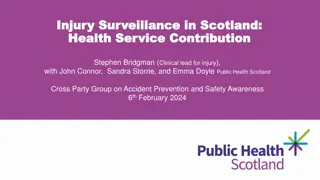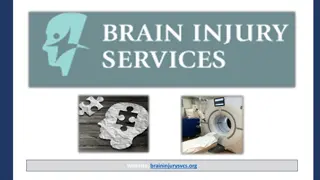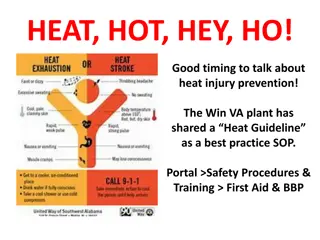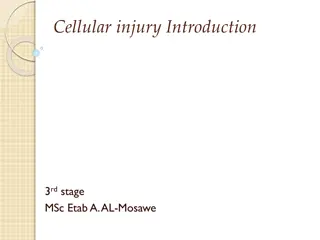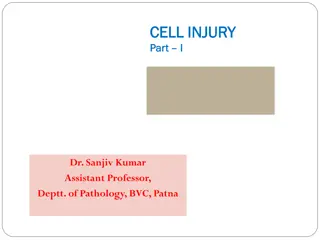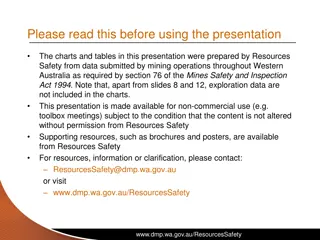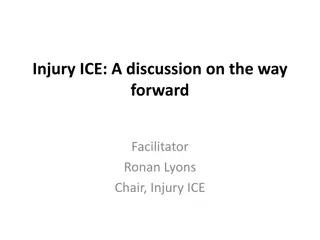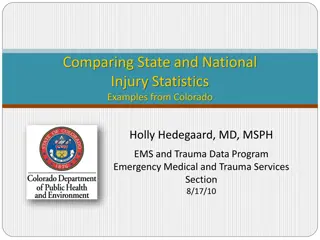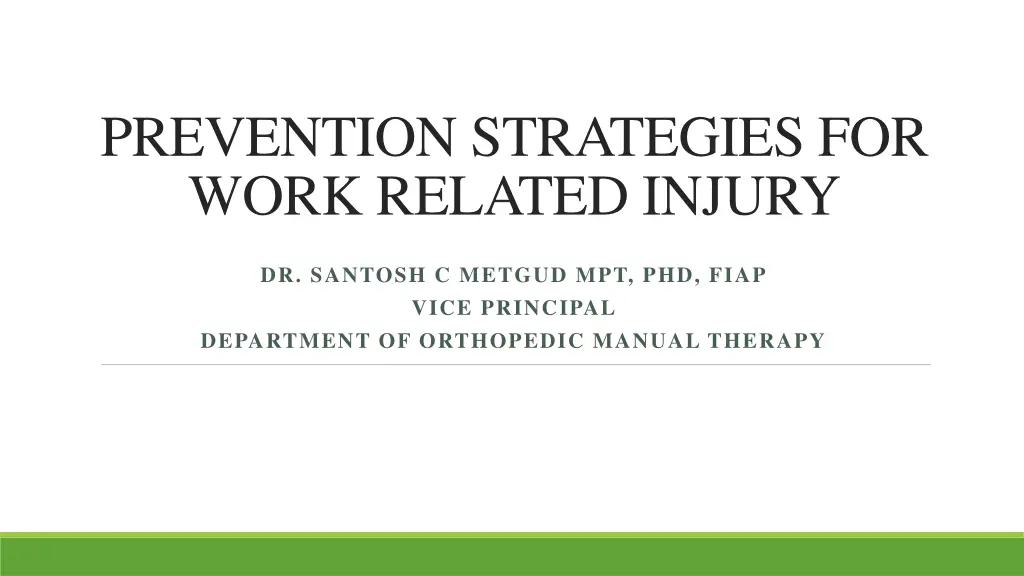
Prevention Strategies for Work-Related Injuries
Discover prevention strategies for work-related injuries, including musculoskeletal disorders, cumulative trauma disorder, repetitive strain disorder, postural problems, and mental health disorders. Learn about the general risk factors for musculoskeletal disorders and the common injuries associated with work-related activities. Explore ways to mitigate the risk of developing painful symptoms and functional impairment due to regular exposure to work activities.
Download Presentation

Please find below an Image/Link to download the presentation.
The content on the website is provided AS IS for your information and personal use only. It may not be sold, licensed, or shared on other websites without obtaining consent from the author. If you encounter any issues during the download, it is possible that the publisher has removed the file from their server.
You are allowed to download the files provided on this website for personal or commercial use, subject to the condition that they are used lawfully. All files are the property of their respective owners.
The content on the website is provided AS IS for your information and personal use only. It may not be sold, licensed, or shared on other websites without obtaining consent from the author.
E N D
Presentation Transcript
PREVENTION STRATEGIES FOR WORK RELATED INJURY DR. SANTOSH C METGUD MPT, PHD, FIAP VICE PRINCIPAL DEPARTMENT OF ORTHOPEDIC MANUAL THERAPY
CONTENTS INTRODUCTION WORK RELATED INJURIES RISK FACTORS COMMON INJURIES ERGONOMICS PREVENTIVE STRATEGIES
INTRODUCTION DEFINATION : WORK RELATED INJURIES: THESE ARE A WIDE RANGE OF INFLAMMATORY AND DEGENARATIVE DISEASES AND DISOREDERS WHICH RESULTS IN PAIN AND FUNCTIONAL IMPAIRMENT. WORK RELATED DISORDERS ARE A RESULT OF COMMON REGULAR EXPOSURE TO WORK ACITIVITES THAT CONTRIBUTE TO DEVELOPMENT OR EXACERBATION OF PAINFUL SYMPTOMS.
WORK RELATED INJURIES WRI can be classified into : Musculoskeletal disorders Cumulative trauma disorder Repetitive strain disorder Postural problems Mental health disorders
Cumulative Trauma disorder Bodily injuries or physical ailments that have developed gradually over periods of weeks, months, or even years as the result of repeated stresses on a particular body part. Example : 1. Raynaud's syndrome (W= 4.9%-20.1% ,M 3.8%-13.5%) 2. Tendonitis (31.25%) 3. Bursitis (79%) 4. Trigger finger (2.6%) 5. Tenosynovitis
Repetitive motion disorder A variety of muscular conditions that result from repeated motions performed in the course of normal work or other daily activities RMDs may be caused by: overexertion incorrect posture muscle fatigue compression of nerves or tissue too many uninterrupted repetitions of an activity or motion friction caused by an unnatural or awkward motion such as twisting the arm or wrist Example: Carpel tunnel syndrome (3.8%) De Quervain s disease (49%)
General Risk factors for Musculoskeletal Disorders Posture Force Repetitive work Vibration Temperature extremes Stress Previous injuries
A study done by the University of Iowa has shown that construction workers hurt! 60% report pain in their lower back 16% report pain in their knees 13% report pain in their wrists and hands 11% report pain in their shoulders and necks
General Risk factors for Mental Health Disorders Time pressure Low social support Unsatisfactory leisure activities Low job control Job attitude and job satisfaction Personal problems death of loved ones financial problems
Risk Factors for Lower body Small work place Work too low/ high Un-adjustable chair/table Sitting with back unsupported
Common injuries for lower back spine Low Back Pain (48% manual workers 60 in house keepers ) Back Strain Sciatica (10% to 40%)
Common injuries for shoulder Impingement syndrome (warehouse worker) Rotator cuff tear (chef)
Rotator cuff injury Prevalence : 4%- 50% Occupations: overhead activities (prolonged shoulder abduction with elbow extension) like painting, polishing, sanding, construction work etc.
Wrist and elbow De Quervains syndrome (dentist) Lateral Epicondylitis (Tennis Elbow) (carpenter) Medial Epicondylitis (Golfer s Elbow) (computer worker ) Carpel tunnel syndrome (industrial workers, heavy keyboard workers) Raynaud's syndrome (painists) Trigger finger (writers)
De quervains syndrome Prevalence: 49% Occupation which includes: cutting,grinding, polishing, hammering etc.
Lateral epicondylitis Prevalence : 1.3% Occupation: unaccustomed forceful movts , forceful grip or repeated supination/pronation include hammering, screwing, window cleaning, floor scrubbing etc.
Medial epicondylitis Prevalence : 0.4% Occupation: common in golfers
Trigger finger Prevalence: 2.6% non diabetic Commonly seen in workers whose jobs require frequent grasping of hard objects. Strategies video
Carpel tunnel syndrome Prevalence : 3.8%
Raynauds syndrome Prevalence : WOMAN: 4.9%- 20.1% MEN : 3.8% -13.5% video
Hip and Knee and Ankle Trochantric bursitis (painter) Piriformis syndrome (truck drivers) Ligament strains (farmer) Acute ankle strain (waiteress)
Trochantric bursitis Prevalence (79.1%)
Piriformis syndrome Prevalence 55.2% with 8 hours of work 44.8% fewer then 8 hours of work
Collateral ligament injury Prevalence : 46% non atletes 54% in atletes
Acute ankle sprain Prevalence
Spine Cervical pain (taxi drivers) Mid thoracic pain (prolong static posture) Lumbo sacral strain( bending and lifting activities) Low Back Pain Neck pain Sciatica
Cervical injury Prevalence : 22.8%
Mid thoracic pain Prevalence :17% in females 9% in males
Lumbo sacral spine Prevalence :office workers 25% health care workers 58%
ERGONOMICS Ergonomics originates from Greek word:- Ergon, meaning work and nomics meaning laws Which literally means laws of work OSHA (occupational health and safety aadministration) defines ergonomics as Designing the job to fit the worker, instead of forcing the worker to fit the job Ergonomics is the science of improving employee performance and well-being in relation to the job tasks, equipment, and the environment.
Desk job Workstation should be arranged in such a way that it makes our work life more comfortable by reducing stress & injury caused by awkward positions and repetitive tasks. WORKSTATION SET-UP DESIGN : The personal space around us within the reaching possibilities of limbs without changing ones position is called Kinesphere. This can be done by correcting placement of equipment such as chairs, keyboard, monitor, mouse, desk, and telephone.
Chairs Chair should have adjustable height and should allow feet to sit flat on the floor. Adjust your backrest tilt and height to help support your backs natural S-Curve. Arms should be freely hanging aside or resting on the arm rest in neutral position.
Design and evaluation of an ergonomic chair for near-ground welding based on muscle activity and usability Reza Tahmasebia, Mehrdad Anbarianb, Sadaf Torkashvandc , Majid Motamedzadea, and Maryam Farhadian TITLE AIM To design an ergonomic chair for near-ground welding operations and evaluate its impact on the electromyography (EMG) activity of a select group of lower limb muscles. METHODOLOG Y The EMG activity of lower limb muscles was measured in eight postures consisting of three postures identified via observing welders at work, and five on-chair postures suggested for chair use during welding. The usability of the designed chair was evaluated through the use of the System Usability Scale (SUS) CONCLUSION Using a suitable chair or support for different work postures can prevent detrimental muscle activities during work and the development of musculoskeletal disorders caused by intense muscle activity due to awkward postures.
Monitors Top of the monitor screen should be at or just below the eye level Distance between the monitor and then individual should be about 20 inch s. Screen positioned at angle of window for ambient lightning and reduce glare
Keyboard Keyboard angle adjusted to ensure neutral wrist Keep a straight wrist position when you are typing. Height and placement of keyboard to ensure relaxed shoulders, straight elbows. Newer Keyboards - Split keyboards Sculpted keyboards
Mouse Keyboard and mouse should be placed on same level. Placement should be such that wrist is in neutral position.
Desk Height adjustable desk should be provided. Items on the desk are within close reach to avoid extended reaching. No sharp edges, corners, protrusions.
Telephone Placed within reach of usual/regular work. Headphones can be used if required for longer duration. Avoid placing in non working area as it causes excessive shoulder and neck movements.
MEDICAL PROFFESIONALS ERGONOMIC TOOL FOR PATIENT AID : Gait belt/Conveyer belt: A gait belt with handles can be used during a stand pivot transfer, guiding a patient along a transfer board and during seated transfers.
Height-adjustable Electric Beds: Have height controls to allow for easy transfers from bed height to wheelchair height. These beds can be kept low to the ground for patient safety and then raised up for interaction with staff.
Slip sheets: Help to reduce friction while laterally transferring patients or repositioning patients in bed and reduce the force workers need to exert to move the patient.
Anti fatigue mats : Reduce fatigue and discomfort in legs and back Increase blood flow and amount of oxygen reaching the heart Polypropylene stain-resistant surface for ease of maintenance
DENTISTRY ERGONOMICS Ergonomics in dentistry involves instruments, work posture and equipments. INSTRUMENTS: Dental Hand Pieces: When selecting hand pieces, look for: Lightweight and balanced models . Hand instruments : Goal: to reduce force exertion while allowing for neutral joint positioning. EQUIPMENT : Equipment should allow to maintain neutral posture and reduce postural deviation. This consists of operator chair. POSTURE: Try and maintain neutral posture and not slouch too much.
PREVENTION STRATEGIES Common stretches to be performed for desk job workers
STRENTHENING EXERCISES : Develop strength in select areas of the body Work through specific areas of deficits Support general improvement within program Strengthen body parts to accommodate mechanical stresses that will eventually be placed on the body Increased localized strength for maintaining static postures necessary for the job.
EYE EXERCISES : BLINKING EYE ROLLING UP AND DOWN VIEWING SIDEWAY VIEWING NOSE TIP GAZING EYE PALMING
TITLE Work-related Musculoskeletal Disorders in Iranian Office Workers: Prevalence and Risk Factors Fariborz et al (2018) INTRODUCTIO N This study aimed to identify the prevalence of musculoskeletal disorders (MSDs) and ergonomic risks for Kerman University of Medical Sciences' office workers. METHODOLO GY The study sample comprised all office workers in the University and the sample included 129 women and 121 men. Data on MSDs were derived from the Nordic Musculoskeletal Questionnaire, while ergonomic data were collected through two direct observations via the rapid upper limb assessment (RULA) and the rapid office strain assessment (ROSA) method CONCLUSION Based on the results, for the prevention of MSDs, there should be ergonomics workshops for workers to be aware of ergonomics factors in the office. The ergonomics training must also be used in offices; the design of workstations should be improved.
TITLE Ergonomic risk factors and work-related musculoskeletal disorders in clinical physiotherapy L. J. Fan1 , S. Liu2 , T. Jin3 , J. G. Gan4 , F. Y. Wang5 , H. T. Wang2 and T. Lin1* OBJECTIVE The purpose of this study was to objectively quantify and evaluate the ergonomic risk of clinical physiotherapy practices and evaluate physiotherapists for work-related musculoskeletal disorders and pain TITLE Work-related Musculoskeletal Disorders in Iranian Office Workers: Prevalence and Risk Factors Fariborz et al (2018) METHODOLOGY Twenty-nine physiotherapists in the rehabilitation department of a large-scale tertiary hospital were recruited in this study. The sampling period lasted for 2 weeks for each physiotherapist and interval sampling was adopted to avoid duplication of cases. Therapist posture during physiotherapy was captured, tracked and analyzed in real time using structured light sensors with an automated assessment program. The quantification of ergonomic risk was based on REBA (Rapid Entire Body Assessment) and the RPE (perceived physical exertion) scores of the therapists were recorded before and after treatment, respectively. r study creates an automatic tool to assess the ergonomic risk of physiotherapy practices and demonstrates unacceptable ergonomic risk in common practices. The high prevalence of musculoskeletal disorders and pains recommends that rehabilitation assistance devices should be optimized and standard ergonomic courses should be included in physiotherapists training plans. CONCLUSION

